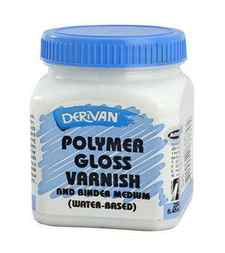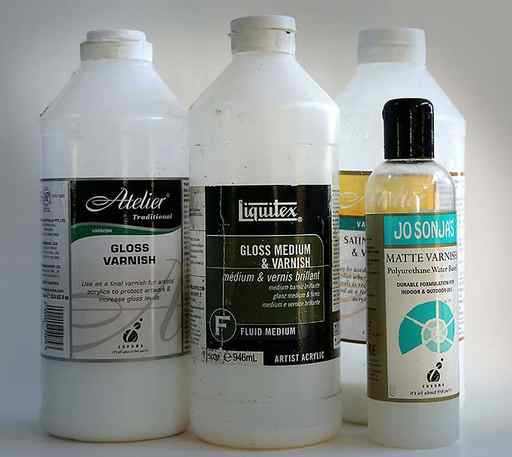Why do I need an acrylic varnish?
Acrylic varnish is a clear coat applied over the top of artwork. It has two main functions- giving it an even sheen, which will help bring out the full intensity and beauty of pigments and protect it from various areas of attack such as wear and tear or airborne grime or chemicals.
When selecting a varnish, one of the first questions that arise is the gloss level required. The gloss level is essential because it can determine how shiny or flat the finish will be on top of your painting. Derivan Acrylic Paints and Derivan Student Paints offer a shine that’s similar across their ranges, but mixing them with water or other mediums can change this dramatically! In the Derivan range of varnishes, we offer two different sheen levels: glossy and matte. Need to know more about varnishing techniques? check out our Varnishing how-to page
GLOSS VARNISH
Derivan Polymer Gloss Varnish – Can be used as a gloss finishing varnish and an acrylic gloss medium. – Mixed with Derivan colours, it increases the gloss and flows characteristics of the paint.
- Non-Yellowing
- Water-based Technology
- archival and acid free
- Excellent levelling properties
- Water-based
- High Gloss
- Acrylic varnishing techniques
- Use with a heavy body and soft body paints
- Mixed Media
- Acrylic Glazing techniques
- Decoupage
- Used as a gloss varnish, it produces strong, protective, clear film free from tackiness or stickiness.
Available in 250ml, 500ml and 2 Litre sizes.

As acrylics dry very rapidly, care should be taken to apply varnish pre-diluted with water (as per directions on labels). Polymer Gloss Varnish applied in very thick layers on a hot day could trap moisture, resulting in a cloudy film which would be very difficult to correct, e.g. all Derivan painting mediums are freely intermixable – Polymer Gloss Varnish will intermix with Spreader Medium to give a glossy glaze effect (however, do not mix turps varnishes with other mediums). Nevertheless, painters are advised to use some discretion in pre-determining their selection of mediums to avoid unwanted effects.
Pictures treated with Polymer Gloss will appear to look like work done with oil paints or shiny enamel. Polymer Gloss Varnish is freely intermixable with Derivan Acrylic.
It is water-based and may appear slightly milky whilst wet. This is an optical effect produced by light refraction of acrylic particles suspended within the water-based film. The effect disappears when the film is dry.
Painting Varnish
The most common way to seal and preserve a work on paper, without using glass, is to coat it with an acrylic varnish. This is a non reversible process, so make sure your painting is signed and finished before applying the painting varnish.

Acrylic painting varnishes come in matt, satin and gloss finishes. They can be brushed or sprayed on to produce an impervious protective final layer. Gouache and pastel can shift in tone with the application of an acrylic picture varnish. The effect is similar to wetting the surface so test before applying the varnish.
Fixatives
If the varnish is to be brushed on and charcoal or pastel are incorporated, a light spray with fixative, before applying the painting varnish, is a good idea. If the varnish is to be sprayed on the fixative is not necessary as there will be no disturbance to the painting surface.
Fixative is available in spray cans or by the bottle. The device (above right) allows fixative to be sprayed on by blowing through the short tube. This is fine on small work, but don’t attempt to fix a mural by this method!
Picture Varnish Application
The best brush for applying Acrylic painting varnish is the short bristle golden nylon. They don’t shed bristles and leave no brush marks. When the painting varnish is first applied it will appear slightly milky but this disappears as it dries. Avoid over brushing when you apply the varnish – just enough to smooth it out. Overworking with a brush can cause the varnish to dry to a milky finish. One or two coats is usually enough. Allow the first coat to dry thoroughly before applying the second coat.
If you are regularly varnishing large areas a cheap compressor and spray gun make the job quick and easy. Make sure your compressor has a water trap on the air line. Three or four light coats applied at ninety degrees to one another give the best coverage.
Spraying in horizontal sweeps and turning the painting around ninety degrees between coats makes application easy. I usually spray on a couple of coats at ninety degrees to one another, let them dry then repeat the process.
Don’t apply the varnish too heavily and create runs.
Acrylic picture varnish is water based so cleaning up spray equipment and brushes is as simple as thoroughly rinsing under a tap.
Wax Painting Varnish
An alternative to Acrylic varnish is a wax varnish. Wax varnishes are made from pure bees wax with solvents added so they can be easily spread. Bees wax has been used as a painting medium and preservative since early Egyptian times. It is one of the most stable and long lasting finishes available.
Bees wax based varnishes are available from a number of manufactures. They all seem to do the same job and appear to be of similar make up. Although they are branded as oil paint varnishes, they all work as a final painting varnish over water based media on paper, canvas or other surfaces.
Application is by brush or simply rubbing in with fingers. Once the wax has been applied to the painting it can be buffed with a soft cloth to the desired gloss.
Wax painting varnish has a greasy, paste like constancy and smells like honey. If you are not keen on getting your hands covered in it, a bristle brush can be used to apply it.
Wax varnish requires more effort to apply but it produces a beautiful, subtle finish that penetrates and seals the surface as it intensifies colors. Wax varnish is always a final step. Once applied to water based media, no further painting can take place.
Wax Varnish Links
Art Spectrum Matt Wax Varnish is available in Australia
Not having to frame water based media under glass means there is no restriction on size and the problem of reflections is removed.
It is a good idea to use a couple of old paintings or specially prepared sacrificial works to test the effects of these painting varnishes. Once you are familiar with the results you can confidently apply these finishes to your work and enjoy the advantages they provide.





